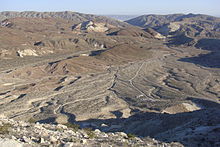Unit-3
Physical Geology
Earth is covered by a thin “veneer” of sediment. The veneer caps igneous and metamorphic “basement.” This sediment cover varies in thickness from 0 to 20 km. It is thinner (or missing) where igneous and metamorphic rocks outcrop, and is thicker in sedimentary basins.
To make this sediment and sedimentary rock, several steps are required:
Weathering – Breaks pre-existing rock into small fragments or new minerals
Transportation of the sediments to a sedimentary basin.
Deposition of the sediment
Burial and Lithification to make sedimentary rock.
Each Step in the process of forming sediment and sedimentary rocks leaves clues in the sediment. These clues can be interpreted to determine the history of the sediment and thus the history of the Earth.
Geologists recognize two categories of weathering processes
Physical Weathering - the disintegration of rocks and minerals by a physical or mechanical process.
Chemical Weathering - chemical alteration or decomposition of rocks and minerals.
Although we separate these processes, as we will see, both work together to break down rocks and minerals into smaller fragments or to minerals more stable near the Earth's surface.Both types are a response to the low pressure, low temperature, and water and oxygen-rich nature of the earth’s surface.
Physical Weathering
The mechanical breakup or disintegration of rock doesn't change mineral makeup. It creates broken fragments or “detritus.” which are classified by size:
Physical weathering takes place through a variety of processes. Among them are:
Joints form as a result of expansion due to cooling or relief of pressure as overlying rocks are removed by erosion.
Igneous plutons crack in onion-like “exfoliation” layers. These layers break off as sheets that slide off of a pluton. Over time, this process creates domed remnants.
Joints form free space in the rock by which other agents of chemical or physical weathering can enter.
Chemical Weathering
Since many rocks and minerals are formed under conditions present deep within the Earth, when they arrive near the surface as a result of uplift and erosion, they encounter conditions very different from those under which they originally formed. Among the conditions present near the Earth's surface that are different from those deep within the Earth are:
Because of these differing conditions, minerals in rocks react with their new environment to produce new minerals that are stable under conditions near the surface. Minerals that are stable under P, T, H2O, and O2 conditions near the surface are, in order of most stable to least stable:
Note the minerals with a *. These are igneous minerals that crystallize from a liquid. Note the minerals that occur low on this list are the minerals that crystallize at high temperatures from magma. The higher the temperature of crystallization, the less stable are these minerals at the low temperature found near the Earth's surface (see Bowen's reaction series in the igneous rocks chapter).
The main agents responsible for chemical weathering reactions are water and weak acids formed in water.

H+ is a small ion and can easily enter crystal structures, releasing other ions into the water.
Types of Chemical Weathering Reactions




Weathering of Common Rocks
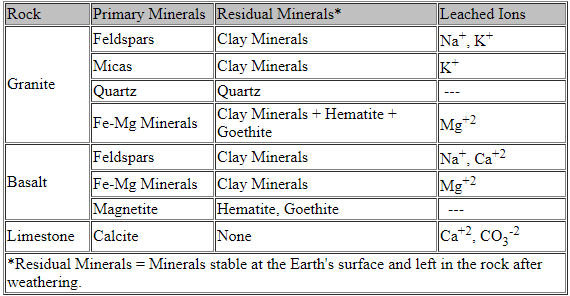
Table 3.1
Factors that Influence Weathering

Fig 3.1
Erosion is the removal of surface material fromEarth’s crust, primarily soil and rock debris, and the transportation of the eroded materials by natural agencies (such as water or wind) from the point of removal.
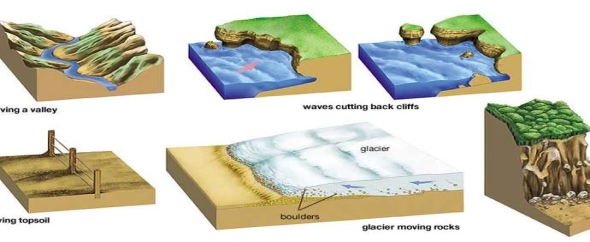
Fig 3.2 Erosion
Water, wind, glaciers, and gravity all can change the land through the processes of erosion.
The broadest application of the term erosion embraces the general wearing down and molding of all landforms on Earth’s surface, including the weathering of rock in its original position, the transport of weathered material, and erosion caused by wind action and fluvial, marine, and glacial processes. This broad definition is more correctly called denudation, or degradation, and includes mass-movement processes. A narrow and somewhat limiting definition of erosion excludes the transport of eroded material by natural agencies, but the exclusion of the transport phenomenon makes the distinction between erosion and weathering very vague. Erosion, therefore, includes the transportation of eroded or weathered material from the point of degradation (such as the side of a mountain or other landform) but not the deposition of material at a new site. The complementary actions of erosion and deposition or sedimentation operate through the geomorphic processes of wind, moving water, and ice to alter existing landforms and create new landforms.
Erosion will often occur after the rock has been disintegrated or altered through weathering. Weathered rock material will be removed from its original site and transported away by a natural agent. With both processes often operating simultaneously, the best way to distinguish erosion from weathering is by observing the transportation of material.
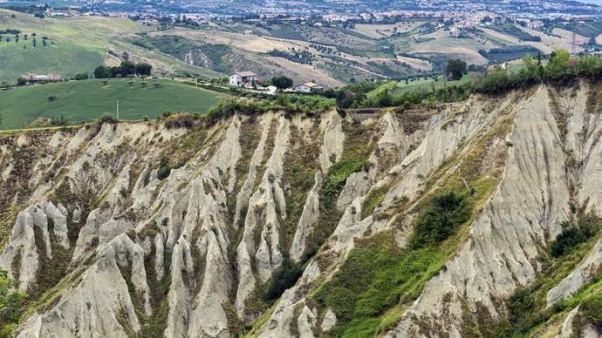
Fig 3.3 Gullies in an eroded hill in Atri, Italy.
Water Erosion
Moving water is the most important natural erosional agent. The wastage of the seacoast, or coastal erosion, is brought about mainly by the action of sea waves but also, in part, by the disintegration or degradation of sea cliffs by atmospheric agents such as rain, frost, and tidal scour. Sea wave erosion is accomplished primarily by hydraulic pressure, the impact of waves striking the shore, and by the abrasion (wearing, grinding, or rubbing away by friction) by sand and pebbles agitated incessantly by the water.
Wave impact and hydraulic action are usually most devastating to human-made coastal features such as breakwaters or moles. The impact and hydraulic action of storm waves are the most significant upon shores composed of highly jointed or bedded rock, which are vulnerable to the quarrying, the hydraulic plucking of blocks of rock. The abrasive action of sand and pebbles washed against shorelines is probably the most significant wave erosional activity. Particles are dragged back and forth by wave action, abrading the bedrock along the coast and abrading each other, gradually wearing pebbles into sand. Wave erosion creates retrograde, or retreating, shorelines with sea cliffs, wave-cut benches at the base of the sea cliffs, and sea arches—curved or rectangularly shaped archways that result from different rates of erosion due to varied bedrock resistance.
Besides the back-and-forth transportation of materials by wave action, sediments are transported by the lateral movement of waves after they wash ashore (beach drifting) or by shallow-water transport just offshore, known as longshore currents. These transportation movements lead to deposition and the formation of prograde or advancing, shorelines, bars, spits, bayhead beaches (a bayhead beach is formed between two headlands), and barrier beaches (a barrier beach parallels the shore).
In rivers and estuaries, the erosion of banks is caused by the scouring action of the moving water, particularly in times of flood and, in the case of estuaries, also by the tidal flow on the ebb tide when river and tidewater combine in their erosive action. This scouring action of the moving water entrains (that is, draws in and transports) sediments within the river or stream load. These entrained sediments become instruments of erosion as they abrade one another in suspended transport or as they abrade other rock and soil as they are dragged along the river bottom, progressively entraining additional sediments as long as the river’s volume and velocity of the stream continue to increase.
As the velocity of the river decreases, the suspended sediments will be deposited, creating landforms such as broad alluvial fans, floodplains, sandbars, and river deltas. The land surface unaffected by rivers and streams is subjected to a continuous process of erosion by the action of rain, snowmelt, and frost, the resulting detritus (organic debris) and sediment being carried into the rivers and thence to the ocean.
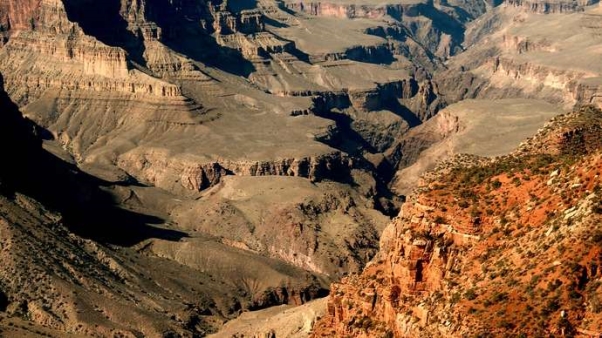
Fig 3.5 Eroded valley
Glacial Erosion
Glacial erosion occurs in two principal ways: through the abrasion of surface materials as the ice grinds over the ground (much of the abrasive action being attributable to the debris embedded in the ice along its base); and by thequarrying or plucking of rock from the glacier bed. The eroded material is transported until it is deposited or until the glacier melts.

Fig 3.6 Glacial erosion
Wind Erosion
In some arid and desert tracts, the wind has an important effect in bringing about the erosion of rocks by driving sand, and the surface of dunes not held together and protected by vegetation is subject to erosion and change by the drifting of blown sand. This action erodes material by deflation—the removal of small loose particles—and by sandblasting of landforms by wind-transported material. Continued deflation of loose particles from landforms leaves behind larger particles that are more resistant to deflation. Wind action transports eroded material above or along the surface of Earth either by turbulent flow (in which particles move in all directions) or by laminar flow (in which adjacent sheets of air slip past one another). The transportation of wind-eroded material continues until the velocity of the wind can no longer sustain the size particle being transported or until the windblown particles collide with or cling to a surface feature.
Force and resistance
This is the most important factor affecting weathering of rocks. The extent of weathering is dependent on the average atmospheric condition prevailing in a region over a long time.
Two factors play in weathering, viz. Temperature and Precipitation. Warm climates affect by chemical weathering while cold climates affect by physical weathering (particularly by frost action). In either case, the weathering is more pronounced with more moisture content.
At higher temperatures, chemical reactions are likely to take place faster. Chemical reactions in most cases need water which is a reactant in hydration and carbonation. Water is also the medium in which the reaction can take place.
Biological activities are supported by hot moist climates. For instance, burrowing humic acid production during the decomposition of plant matter is most likely in hot moist climates. A hot moist climate provides the most ideal environment for fast chemical weathering.
Physical weathering by frost action is most likely in a cold climate where freeze and thaw occur alternately during the cold weather. In this case, again precipitation is the main factor. In the absence of water, ice cannot form, and frost action is not possible. Hence an effective frost action occurs in the cold moist climate.
2. Particle Size:The rate of chemical weathering is affected by the size of rock particles. If the rock pieces are smaller, the weathering is faster. This is because if the rock pieces are smaller, the surface area exposed to weather action is greater.
3. Exposure:The extent of exposure i.e. the extent to which the rock comes into contact with the agents of weather is an important factor affecting the weathering. In some situations, vegetation, soil, ice, etc. may cover a rock, thereby reducing the area exposed to weather action.
Such rocks so protected weather slowly compared to rocks whose surfaces are wholly exposed to the weather. The slope of the region is also a factor affecting weathering. Where the slopes are steep, loose materials are displaced downhill either by gravity or by erosion resulting in continuous exposure of the fresh rock.
4. Mineral Composition:We know, the chemical properties of a rock depend on the mineral composition to a great extent. Mineral in a rock may readily react with acids, water, or oxygen causing considerable weathering. For example, limestone can get severely acted upon by even very mildly acidic rainwater. Granite on the contrary mostly containing silica remains unaffected by such agents.
Physical weathering is also dependent on mineral composition. Soft rocks are liable to be abraded more readily than hard rocks. The solid crystalline rocks are quite compact with very little opening and are very resistive to the entry of water into them, and can therefore resist weathering.
5. Time:The process of weathering is a time taking process. The duration of time for which rock is exposed to weather determines the extent of weathering. Very strong rocks, however strong they might be will severely undergo weathering in hundreds of years.
1. Landforms created by weathering
Removal of the weathered byproducts by erosion is an integral part of any landform development, and there are an infinite variety of landforms created by differential weathering and erosion. A few landforms, where the form is dominated by the style of weathering are presented here, others are covered later under other sections.
2. Sediment and soils
Weathering and erosion fine-tune the landscape. Tectonics and internal adjustments rough it out, but weathering and erosion etch it, cover it, and create many of the fine details. I use the term disintegration landforms for features created by mechanical and chemical weathering acting on largely insoluble rocks. These landforms reflect styles of disintegration and differential weathering. In contrast, solution landforms are formed in the soluble rock. These features are covered in the karst outline.
Disintegration landforms
Inselbergs, tors, and bonharts and exfoliation domes
Inselbergs
Inselbergs (german, island hill) are isolated rock hills created by long-term weathering and erosion. Bonharts and tors are varieties of inselbergs. These hills are steep-sided and typically lack talus at the base suggesting that they were created by deep weathering and exhumation rather than dissection and slope retreat. Joints play an important role in their formation.
Tors
Tors (Fig 3.7b) are residual rock masses that display as isolated piles of boulders. Although they typically form in granite they also developed in other lithologies. Linton (1955) theorized a two-stage process of formation. The first involves the deep penetration of weathering along jointed bedrock, which produces a thick saprolite mantle intersperse with unweathered corestones(Fig. 3.7 a). The second stage is brought on by exhumation either by tectonic uplift or lowering of base level. The granular saprolite is quickly removed from wind and water leaving behind the rounded corestone (Fig. 3.7b).

Fig 3.7a Deeply weathered granite in the Sierra Nevada Mts
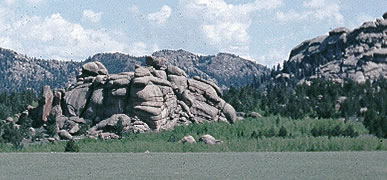
Fig 3.7 b. Granite tors
Bornhardts
Bornhardts are distinct steep-sided, dome-shaped hills. Unlike tors, they are composed of relatively unjointed rock, except for large curved surface joints. These large rounded monoliths are purported to be formed by exfoliation following the removal of neighboring weak rock. Probably the two most famous bornhardts are Half Dome in Yosemite Valley, CA, and Ayers Rock in Australia. Bornhardts are largely isolated exfoliation domes. Not all bornhardts are necessarily considered inselbergs. Half Dome for example, no longer rises above a plain but rather a rugged glaciated alpine landscape. As with tors, exhumation is most likely is important in their development.
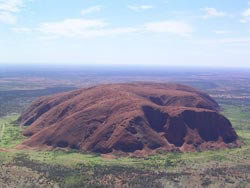
Fig 3.8. Ayers Rock (Uluru)
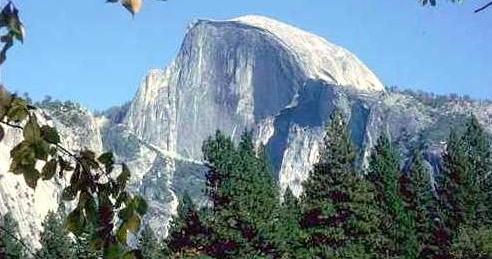
Fig 3.9 Half Dome
Weathering pits and cavities
Weathering Pits
Weathering pits are depressions created where water ponds in irregularities on rock surfaces. The trapped water localizes chemical weathering and granular disintegration. Wind and water remove the loosened grains and the depressions enlarge trapping more water in a positive feedback cycle.
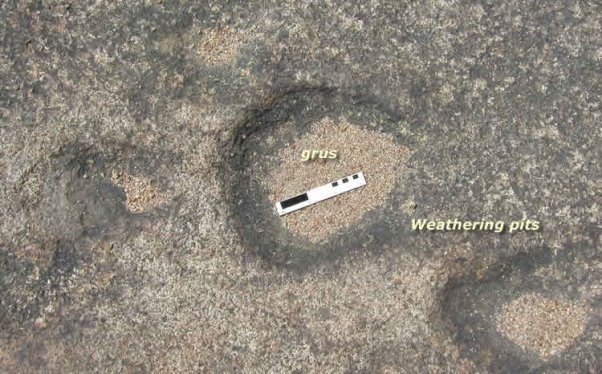
Fig 3.10 Weathering pits
Tafoni (small caverns)
Tafoni is a unique type of pitted surface formed by alveolar (honeycomb) weathering, a style of weathering resulting from salt weathering, and differential solution and precipitation of solutes in sandstones having a soluble cement. The weathering creates pocket-like caverns on rock surfaces, usually sandstones with calcareous cement.
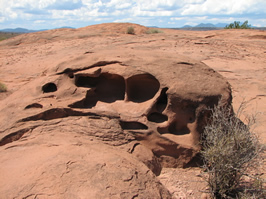
Fig 3.11 Tafoni
Rubble fields and slopes
Fields and slopes of blocky rubble are common in an alpine and periglacial setting where freeze-thaw dominates. Examples of such features include:
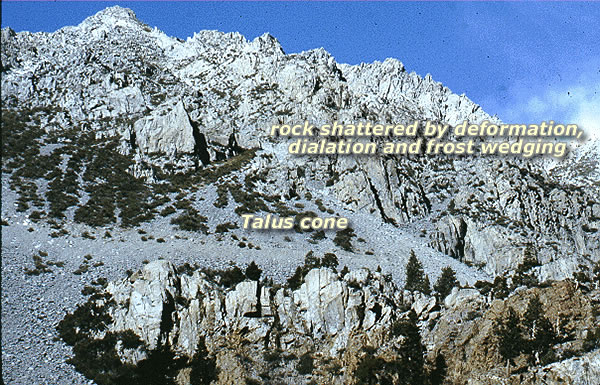
Fig 3.12 Talus (scree slope)
Fins, Alcoves, arches, and hoodoos
These are unique features formed by varying styles of disintegration and erosion of horizontally bedded and vertically jointed rock. They are common features of the Colorado Plateau Province.
Fins
Fins are residual walls of rock that remain after the adjacent rock has been removed along with systematic parallel joint sets. Such joints are typically formed by tensional stresses along anticlinal or monoclinal fold axes. The joints leading to the creation of the Courthouse Towers (fig. 3.13) in Arches National Park formed a thick sandstone (Slickrock Member of the Kayenta Formation) and are attributed to the deformation and subsequent collapse of the salt-cored anticline.
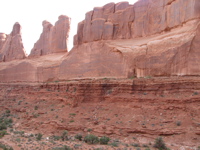
Fig 3.13 Fins
Hoodoos
Hoodoos are rock pinnacles formed by differential weathering and erosion of vertically-jointed horizontal beds of shale interbedded with thin resistant beds of limestone, sandstone, or conglomerate. The best examples and type locality of hoodoos occur in Bryce Canyon, Utah.
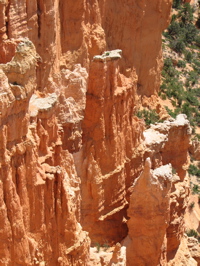
Fig 3.14 Hoodoos
Alcoves and Arches
Alcoves and arches are weathering features common in the dissected horizontal strata of the Colorado Plateau. They form where chemical and physical weathering is concentrated along horizontal discontinuities where water and salts concentrate, such as the contact between sandstone and underlying shale bed. Once formed, an alcove enlarges, often through exfoliation. Indians in the American Southwest built cliff dwellings in natural alcoves, enlarging them by digging out any soft weathered rock and using jointed blocks to enclose them. Arches form where alcoves breakthrough residual fins of rock created by erosion along joints.
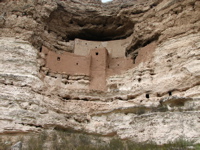
Fig. 3.15Alcove

Fig 3.16 North Window arch
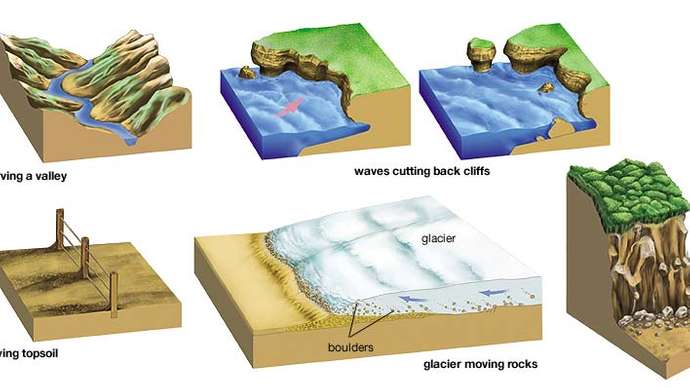
Fig 3.17 Alcoves, arches, and hoodoos
Regolith, Overburden
The general definition of the above terms: Disintegrated and decomposed mineral and organic matter occurring naturally on the surface of the earth.
Regolith and Overburden:
The terms regolith and overburden are general terms applied to any sediment overlying bedrock. They may be transported or formed insitu by weathering. Transported regolith includes glacial, fluvial, colluvial, lacustrine, marine, or aeolian deposits. Except for rare saprolite localities, the regolith in New England and the Upper Midwest is transported, mostly by glaciers and their meltwater by-products. Insitu soils are found south of the glacial limit. Transported regolith also occurs in alluvial valleys and deserts.
More Terms
Engineering Considerations of Weathering are as follows –
Superficial deposits refer to geological deposits typically of Quaternary age (less than 2.6 million years old). These geologically recent unconsolidated sediments may include stream channel and floodplain deposits, beach sands, talus gravels, and glacial drift and moraine. All pre-Quaternary deposits are referred to as bedrock.
Types
There are several types of superficial deposits, including raised beaches and brick-earth. These were formed in periods of climate change during the ice ages. The raised beaches were generally formed during periods of higher sea level when ice sheets were at a minimum, and the sand and shingle deposits can be seen in many low cliffs. The brick-earth is originally wind-blown dust deposited under extremely cold, dry conditions but much has been re-deposited by floodwater and mixed with flints.
Superficial deposits were originally recorded only onshore and around the coast where they were laid down by various natural processes such as action by ice, water, and wind. More recently offshore deposits have been mapped and may be separate sea-bed sediments.
Most of these superficial deposits are unconsolidated sediments such as gravel, sand, silt, and clay, and onshore they form relatively thin, often discontinuous patches. Almost all of these deposits were formerly classified based onthe mode of origin with names such as, 'glacial deposits', 'river terrace deposits' or 'blown sand'; or on their composition such as 'peat'.
Categories | Types of superficial deposits |
Generally high permeability | Blown sand Glacial sand and gravel Raised beach and marine deposits River terrace deposits (mainly sand and gravel) Sand and gravel of uncertain age and origin |
Generally low permeability | Clay with flints Lacustrine flints, silts, and sands Peat |
Mixed permeability | Alluvium (including River Terrace deposits in Scotland) Boulder clay and morainic drift Brickearth, mainly loess Landslip |
Table 3.1
Importance
Superficial deposits (residual, colluvial, alluvial) are important as environmental resources in tropical environments. An understanding of their formation through varying periods is essential to a correct interpretation of their economic and hazard potentials. This requires an integration of process studies with a reconstruction of longer-term development. Saprolite formation is considered over 105‐107 yr, while colluvial and alluvial sediments are commonly Late Quaternary (103‐105 yr) in age. It is seen that geomorphologists can often make their most important contributions to developing areas by offering a sound interpretation of landsurfaces and their underlying deposits for engineers, geologists, and pedologists, with whom a close working relationship is essential.
A waterfall is a river or other body of water's steep fall over a rocky ledge into a plunge pool below. Waterfalls are also called cascades.The process of erosion, the wearing away of earth, plays an important part in the formation of waterfalls. Waterfalls themselves also contribute to erosion.
Often, waterfalls form as streams flow from soft rock to hard rock. This happens both laterally (as a stream flows across the earth) and vertically (as the stream drops in a waterfall). In both cases, the soft rock erodes, leaving a hard ledge over which the stream falls.
A fall line is an imaginary line along which parallel rivers plunge as they flow from uplands to lowlands. Many waterfalls in an area help geologists and hydrologists determine a region's fall line and underlying rock structure.
As a stream flows, it carries sediment. The sediment can be microscopic silt, pebbles, or even boulders. Sediment can erode stream beds made of soft rock, such as sandstone or limestone. Eventually, the stream's channel cuts so deep into the stream bed that only a harder rock, such as granite, remains. Waterfalls develop as these granite formations form cliffs and ledges.
A stream's velocity increases as it nears a waterfall, increasing the amount of erosion taking place. The movement of water at the top of a waterfall can erode rocks to be very flat and smooth. Rushing water and sediment topple over the waterfall, eroding the plunge pool at the base. The crashing flow of the water may also create powerful whirlpools that erode the rock of the plunge pool beneath them.
The resulting erosion at the base of a waterfall can be very dramatic, and cause the waterfall to "recede." The area behind the waterfall is worn away, creating a hollow, cave-like structure called a "rock shelter." Eventually, the rocky ledge (called the outcropping) may tumble down, sending boulders into the stream bed and plunge pool below. This causes the waterfall to "recede" many meters upstream. The waterfall erosion process starts again, breaking down the boulders of the former outcropping.
Erosion is just one process that can form waterfalls. A waterfall may form across a fault, or crack in the Earth’s surface. An earthquake, landslide, glacier, or volcano may also disrupt stream beds and help create waterfalls.
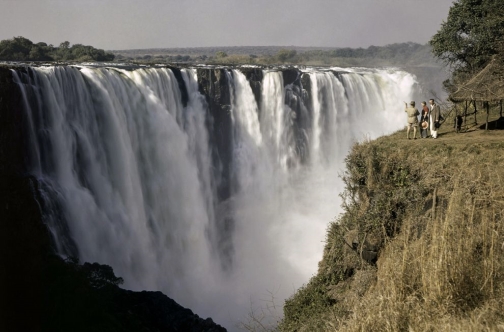
Fig 3.18 Victoria Falls, Zimbabwe
Classifying Waterfalls
Types of Waterfalls
One of the most popular, if least scientific, ways to classify waterfalls is by type. A waterfall's type is simply the way the descends. Most waterfalls fit more than one category.
ii. A cascade is a waterfall that descends over a series of rock steps. Monkey Falls, in the Indira Gandhi Wildlife Sanctuary and National Park in Tamil Nadu, India, is a gently sloping cascade. The waterfall is safe enough for children to play in the water.
iii. A cataract is a powerful, even dangerous, waterfall. Among the widest and wildest of cataracts are the thundering waters of the Iguazu River on the border between Brazil and Argentina.
iv. A chute is a waterfall in which the stream passage is very narrow, forcing water through at unusually high pressure. Three Chute Falls is named for the three "chutes" through which the Tenaya Creek falls in Yosemite National Park, California.
v. Fan waterfalls are named for their shape. Water spreads out horizontally as it descends. Virgin Falls is a striking fan waterfall on Tofino Creek, on Vancouver Island, British Columbia, Canada.
vi. Frozen waterfalls are just what they sound like. For at least part of the year, the waterfall freezes. Mountaineers often climb frozen waterfalls as a challenging test of their skill. The Fang is a single pillar of ice in Vail, Colorado that vertically plunges more than 30 meters (100 feet).
vii. Horsetail waterfalls maintain contact with the hard rock that underlies them. Reichenbach Falls, a fall on the Reichenbach Stream in Switzerland, is a horsetail waterfall where legendary detective Sherlock Holmes allegedly fell to his doom.
viii. Multi-step waterfalls are a series of connected waterfalls, each with its plunge pool. The breathtaking "falling lakes" of Plitvice Lakes National Park, Croatia, are a series of multi-step waterfalls.
ix. Plunge waterfalls, unlike horsetail falls, lose contact with the hard rock. The tallest waterfall in Japan, Hannoki Falls, is a plunge waterfall that stands 497 meters (1,640 feet). Hannoki Falls is seasonally fed by snowmelt from the Tateyama Mountains.
x. Punchbowl waterfalls are characterized by wide pools at their base. Wailua Falls is a punchbowl waterfall on the island of Kauai, Hawaii. Although the plunge pool is tranquil and popular for swimming, the area around Wailua Falls itself is dangerous.
xi. The water flowing over segmented waterfalls separates as distinct streams. Huge outcroppings of hard rock separate the streams of Nigretta Falls, a segmented waterfall in Victoria, Australia, before they meet in a large plunge pool.
A gorge is a narrow valley with steep, rocky walls located between hills or mountains. The term comes from the French word gorge, which means throat or neck. A gorge is often smaller than a canyon, although both words are used to describe deep, narrow valleys with a stream or river running along their bottom.
Several natural forces form gorges. The most common is erosion due to streams or rivers. Streams carve through hard layers of rock, breaking down or eroding it. Sediment from the worn-away rock is then carried downstream. Over time, this erosion will form the steep walls of a gorge. The flooding of streams or rivers increases the speed and intensity of this erosion, creating deeper and wider gorges. The deep Talari Gorges in Mali, for instance, were formed by the Senegal River that flows into the Atlantic Ocean on the western coast of Africa.
Geologic uplift also forms gorges. Geologic uplift is the upward movement of the Earth's surface. Geologic uplift is often associated with earthquakes and orogeny, the process of creating mountains. During geologic uplift, rock layers beneath the Earth's surface bump against the surface layers. Softer layers of surface rock erode.
Erosion and geologic uplift often work together to create gorges. Parts of streams or rivers can be elevated, along with land, during the process of geologic uplift. As rivers or streams flow across this uplifted surface, waterfalls form. Over time, the power of the waterfall erodes the softer rock layers underneath, causing the original river bed to collapse and create a gorge. Macocha Gorge in the Jihomoravsk region of the Czech Republic was probably formed by the collapse of an underground cave that had been eroded by the Punkva River.
The movement and melting of glaciers can also produce gorges. Glaciers cut deep valleys into the Earth's surface. These rivers of ice can create huge canyons and sharp, steep gorges. As glaciers melt or retreat, these gorges and canyons are exposed. The Columbia River Gorge, located in the U.S. states of Washington and Oregon, was partially created by glacial retreat during the last Ice Age.
Engineers have purposely flooded gorges to create waterways and dams. These dams generate hydroelectricity or electricity powered by water. The Three Gorges Dam on the Yangtze River in China is probably the most famous example of such a project. Upstream from the dam, the Qutang, Wu, and Xilang gorges were partially submerged to create a waterway. The new waterway would allow freight ships to navigate from the East China Sea, part of the Pacific Ocean, to the city of Chongqing, about 2,250 kilometers (1,400 miles) inland. The 26 turbines of the Three Gorges Dam generate approximately 18,000 megawatts of electricity for Shanghai and other cities. However, many people worry about the environmental impacts of the dam and criticize the fact that more than a million Chinese families were forced to move from their homes near the gorges to complete theconstruction.
Many geological discoveries have been made at gorges because gorges often expose layers of rock that go back thousands of years. Olduvai Gorge in Tanzania has layers dating as far back as 2 million years. The Olduvai Gorge is famous for the fossils and ancient tools found there by scientists Louis, Mary, and Richard Leakey. These remains of ancient animals and plants provide clues about early humans.
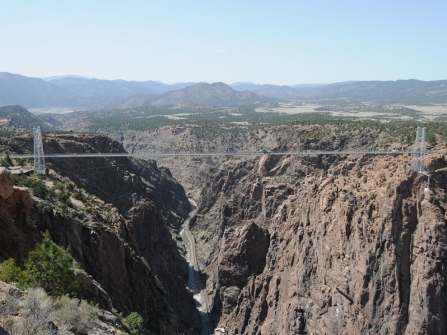
Fig 3.19 Royal Gorge Bridge
Meandering Rivers are located on flat terrain that reduces the flow speed of the water, allowing the river to curve or "meander". The bends in the river will migrate back and forth within the river valley. There is a differentiation in flow speeds within a meandering river channel that produces areas of erosion and deposition. There are distinct sedimentary structures that result from this process.
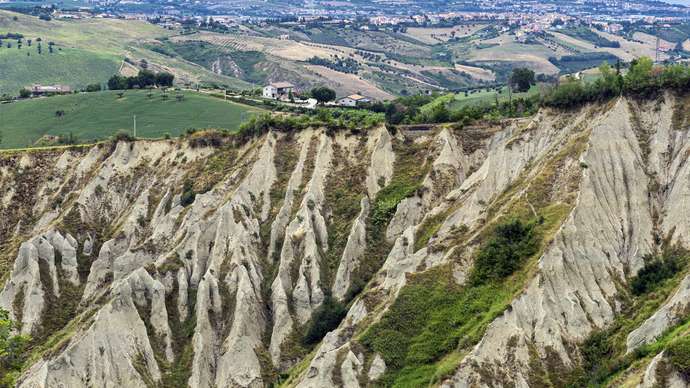
Fig 3.20 Aerial photograph of a meandering river.
Sediment Erosion/DepositionWhen the water moves around a curve, the velocity of the water is highest along the outer part of the channel. This area is referred to as the bank of the channel, and it is where erosion of sediment occurs. Erosion is caused by the increase in flow velocity, which has the force to erode and transport sediment from the bank. On the inside bend of the river, known as the point bar, water velocity is slower because it doesn't have to travel as far as the water on the outside of the bend. This allows sediment to settle out and be deposited. As this cycle of erosion and deposition continues, the river will migrate in its river valley. This migration can lead to the creation of an oxbow lake.
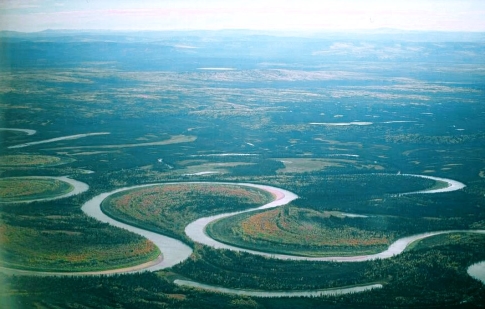
Fig 3.21 An oxbow lake
Sedimentary Deposits/Structures
Due to the higher velocity in the middle and outside bend of the river channel, coarser sediment will be deposited in those areas. The coarser grains will be transported to these parts of the river channel because the higher velocity can transport the heavier grains. This is related to the concept of Reynolds Number, which measures whether sediment transport of a specific grain size will be able to occur based on the velocity of the water.
Two distinct areas within the river channel are characterized by different flow speeds and grain size, the outer edge and the inner bend of the channel. The different flow speeds will carry different-sized sediment grains, which will produce an asymmetrical cross-section. The coarser grains will be present in the outer edges of the channel, while finer sediment will be along the inside of the channel. The different flow speeds within the channel, along with the different grain sizes, will produce unique sedimentary structures. The coarser-grained areas that result from a faster flow speed will have upper planar lamination or dune cross-stratification. The point bar of the river will produce current ripple lamination, due to the finer sediment and slower flow speeds. As the river migrates towards the direction of the eroding bank, the current ripples of the point bar will end up being deposited on top of the planar lamination/dune cross-stratification of the bank.
Facies/Stratigraphic Column
The typical facies that occur within a meandering river environment include a scoured base of flow, which is caused by the high flow velocity in the middle of the channel that can pick up and transport large sediment particles. There would also be a lag deposit of mud rip-up clasts and the coarsest sediment within the facies. A lag deposit is where physical processes remove the finer sediment, leaving behind the coarse grains. As we move upward in the stratigraphic column, the grain size will become finer. The structures you should find are trough cross-stratification, rippled sands, and sigmoidal cross-stratification resulting from the point bar migration.
Periodically, the river will flood, causing its floodplain to fill with fine-grained sediment. This is due to the water flow velocity decreasing as it flows away from the river channel. More information on floodplains can be found on the previously linked page on Oxbow Lakes and Floodplains. The floodplain facies will be incorporated into the typical meandering river facies.
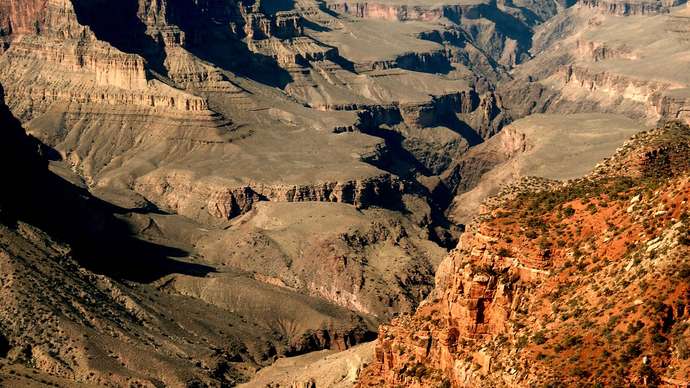
Fig 3.22 A typical stratigraphic column for a meandering river system
There are also key differences in the facies for a meandering river channel and a braided river channel. Braided river channels will have coarser grain sizes due to their faster flow speeds. Meandering rivers carry lots of sediment within suspension that will be deposited in the structures associated with this environment, including point bars and oxbow lakes. Lastly, the migration of meandering rivers is more uniform in direction than a braided river because it will always migrate towards the eroding bank. A braided channel will migrate in many directions at the same time.
The alluviumis loose, unconsolidated (not cemented together into a solid rock) soil or sediment that has been eroded, reshaped by water in some form, and redeposited in a non-marine setting. The alluvium is typically made up of a variety of materials, including fine particles of silt and clay and larger particles of sand and gravel. When this loose alluvial material is deposited or cemented into a lithological unit or lithified, it is called an alluvial deposit.
The term "alluvium" is not typically used in situations where the formation of the sediment can be attributed to another geologic process that is well described. This includes (but is not limited to): lake sediments (lacustrine), river sediments (fluvial), or glacially-derived sediments (glacial till). Sediments that are formed or deposited in a perennial stream or river are typically not referred to as alluvial.
Age
Most alluvium is geologically Quaternary in age and is often referred to as "cover" because these sediments obscure the underlying bedrock. Most sedimentary material that fills a basin ("basin fill") that is not lithified is typically lumped together as "alluvial". On basis of their ages it is divided into two types:
Alluvium of Pliocene age occurs, for example, in parts of Idaho. Alluvium of the late Miocene age occurs, for example, in the valley of the San Joaquin River, California.
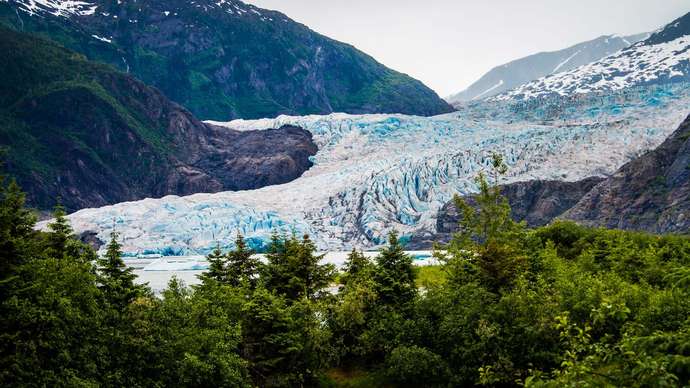
Fig 3.23 Section of alluvium at the Blue Ribbon Mine in Alaska
Alluvial fan
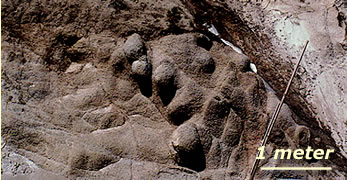
Fig 3.24 Alluvial fan in the French Pyrenees
An alluvial fan is an accumulation of sediments shaped like a section of a shallow cone, with its apex at a point source of sediments, such as a narrow canyon emerging from an escarpment. They are characteristic of mountainous terrain in arid to semiarid climates but are also found in more humid environments subject to intense rainfall and areas of modern glaciation. They range in area from less than 1 square kilometer (0.39 sq mi) to almost 20,000 square kilometers (7,700 sq mi).
Alluvial fans typically form where flow emerges from a confined channel and is free to spread out and infiltrate the surface. This reduces the carrying capacity of the flow and results in the deposition of sediments. The flow can take the form of infrequent debris flows or one or more ephemeral or perennial streams.
Alluvial plain
Fig 3.25 A small, incised alluvial plain
An alluvial plain is a largely flat landform created by the deposition of sediment over a long time by one or more rivers coming from highland regions, from which alluvial soil forms. A floodplain is part of the process, being the smaller area over which the rivers flood at a particular period, whereas the alluvial plain is the larger area representing the region over which the floodplains have shifted over geological time.
As the highlands erode due to weathering and water flow, the sediment from the hills is transported to the lower plain. Various creeks will carry the water further to a river, lake, bay, or ocean. As the sediments are deposited during flood conditions in the floodplain of a creek, the elevation of the floodplain will be raised. As this reduces the channel floodwater capacity, the creek will, over time, seek new, lower paths, forming a meander (a curving sinuous path). The leftover higher locations, typically natural levees at the margins of the flood channel, will themselves be eroded by lateral stream erosion and from local rainfall and possibly wind transport if the climate is arid and does not support soil-holding grasses. These processes, over geologic time, will form the plain, a region with little relief (local changes in elevation), yet with a constant but small slope.
Bay mud
Bay mud consists of thick deposits of soft, unconsolidated silty clay, which is saturated with water; these soil layers are situated at the bottom of certain estuaries, which are normally in temperate regions that have experienced cyclical glacial cycles.
Bay mud manifests low shear strength, high compressibility, and low permeability, making it hazardous to build upon in seismically active regions like the San Francisco Bay Area.
The typical bulk density of bay mud is approximately 1.3 grams per cubic centimeter. Bay muds often have a high organic content, consisting of decayed organisms at lower depths, but may also contain living creatures when they occur at the upper soil layer and become exposed by low tides; then, they are called mudflats, an important ecological zone for shorebirds and many types of marine organisms. Great attention was not given to the incidence of deeper bay muds until the 1960s and 1970s when development encroachment on certain North American bays intensified, requiring geotechnical design of foundations.
Bay mud has its official geological abbreviation.The designation for Quaternary older bay mud is Qobm and the acronym for Quaternary younger bay mud is Qybm. An alluvial layer is often found overlying the older bay mud.
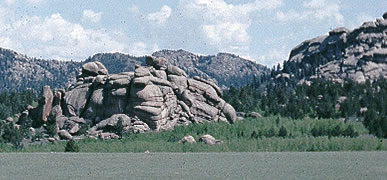
Fig 3.26 Richardson Bay mudflats show exposed layers of bay mud
Braided Rivers
A braided river, or braided channel, consists of a network of river channels separated by small, often temporary, islands called braid bars or, in English usage, aits or eyots. Braided streams tend to occur in rivers with high sediment loads and/or coarse grain sizes, and in rivers with steeper slopes than typical rivers with straight or meandering channel patterns. They are also associated with rivers with rapid and frequent variation in the amount of water they carry, i.e., with "flashy" rivers, and with rivers with weak banks. Braided channels are found in a variety of environments all over the world, including gravelly mountain streams, sand-bed rivers, on alluvial fans, on river deltas, and across depositional plains.
Sediments transported and deposited during the Pleistocene glaciations are abundant throughout Canada. They are important sources of construction materials and are valuable as reservoirs for groundwater. Because they are almost all unconsolidated, they have significant implications for mass wasting.
Figure 3.27 illustrates some of the ways that sediments are transported and deposited. The Bering Glacier is the largest in North America, and although most of it is in Alaska, it flows from an icefield that extends into southwestern Yukon. The surface of the ice is partially, or in some cases completely, covered with rocky debris that has fallen from surrounding steep rock faces. Muddy rivers are issuing from the glacier in several locations, depositing sediment on land, into Vitus Lake, and directly into the ocean. Dirty icebergs are shedding their sediment into the lake. And, not visible in this view, sediments are being moved along beneath the ice.

Fig 3.27 Part of the Bering Glacier in southeast Alaska
The formation and movement of sediments in glacial environments are shown diagrammatically in Figure 16.30. There are many types of glacial sediment generally classified by whether they are transported on, within, or beneath the glacial ice. The main types of sediment in a glacial environment are described below.
Supraglacial (on top of the ice) and englacial (within the ice) sediments that slide off the melting front of a stationary glacier can form a ridge of unsorted sediments called an end moraine. The end moraine that represents the farthest advance of the glacier is a terminal moraine. Sediments transported and deposited by glacial ice are known as till.
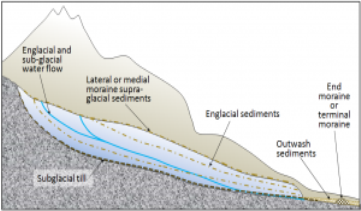
Fig 3.28 A depiction of the various types of sediments associated with glaciation.
Subglacial sediment (e.g., lodgement till) is material that has been eroded from the underlying rock by the ice, and is moved by the ice. It has a wide range of grain sizes, including a relatively high proportion of silt and clay. The larger clasts (pebbles to boulders in size) tend to become partly rounded by abrasion. When a glacier eventually melts, the lodgement till is exposed as a sheet of well-compacted sediment ranging from several centimeters to many meters in thickness. Lodgement till is normally unbedded. An example is shown in Figure 3.29a.
Supraglacial sediments are primarily derived from freeze-thaw eroded material that has fallen onto the ice from rocky slopes above. These sediments form lateral moraines and, where two glaciers meet, medial moraines. Most of this material is deposited on the ground when the ice melts and is therefore called ablation till, a mixture of fine and coarse angular rock fragments, with much less sand, silt, and clay than lodgement till. An example is shown in Fig 3.29b. When supraglacial sediments become incorporated into the body of the glacier, they are known as englacial sediments.
![Figure 16.31 Examples of glacial till: a: lodgement till from the front of the Athabasca Glacier, Alberta; b: ablation till at the Horstman Glacier, Blackcomb Mountain, B.C. [SE]](https://glossaread-contain.s3.ap-south-1.amazonaws.com/epub/1642802707_0164442.png)
Fig 3.29 Examples of glacial till
Massive amounts of water flow on the surface, within, and at the base of a glacier, even in cold areas, and even when the glacier is advancing. Depending on its velocity, this water can move sediments of various sizes and most of that material is washed out of the lower end of the glacier and deposited as outwash sediments. These sediments accumulate in a wide range of environments in the proglacial region (the area in front of a glacier), most in fluvial environments, but some in lakes and the ocean. Glaciofluvial sediments are similar to sediments deposited in normal fluvial environments and are dominated by silt, sand, and gravel. The grains tend to be moderately well rounded, and the sediments have similar sedimentary structures (e.g., bedding, cross-bedding, clast imbrication) to those formed by non-glacial streams (Fig 3.30a and 3.30b).
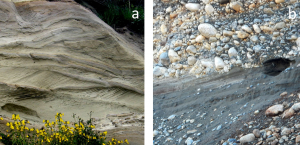
Figure 3.30 Examples of glaciofluvial sediments
A large proglacial plain of sediment is called a sander (a.k.a. an outwash plain), and within that area, glaciofluvial deposits can be tens of meters thick. In situations where a glacier is receding, a block of ice might become separated from the main ice sheet and become buried in glaciofluvial sediments. When the ice block eventually melts, a depression forms, known as a kettle, and if this fills with water, it is known as a kettle lake (Fig 3.31).
![Figure 16.33 A kettle lake amid vineyards and orchards in the Osoyoos area of B.C. [SE]](https://glossaread-contain.s3.ap-south-1.amazonaws.com/epub/1642802707_1396525.png)
Fig 3.31 A kettle lake
A subglacial stream will create its channel within the ice, and sediments that are being transported and deposited by the stream will build up within that channel. When the ice recedes, the sediment will remain to form a long sinuous ridge known as an esker. Eskers are most common in areas of continental glaciation. They can be several meters high, tens of meters wide, and tens of kilometers long (Fig 3.32).
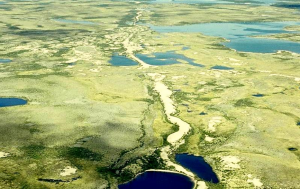
Fig 3.32 Part of an esker
Outwash streams commonly flow into proglacial lakes where glaciolacustrine sediments are deposited. These are dominated by silt- and clay-sized particles and are typically laminated on the millimeter scale. In some cases, varves develop; varves are series of beds with distinctive summer and winter layers: relatively coarse in the summer when melt discharge is high, and finer in the winter when discharge is very low. Icebergs are common on proglacial lakes, and most of them contain englacial sediments of various sizes. As the bergs melt, the released clasts sink to the bottom and are incorporated into the glaciolacustrine layers as dropstones (Fig 3.33a).
The processes that occur in proglacial lakes can also take place where a glacier terminates in the ocean. The sediments deposited there are called glaciomarine sediments (Fig 3.33b).
![Figure 16.35 Examples of glacial sediments formed in quiet water: a: glaciolacustrine sediment with a drop stone, Nanaimo, B.C.; and b: a laminated glaciomarine sediment, Englishman River, B.C. Although not visible in this photo, the glaciomarine sediment has marine shell fossils. [SE]](https://glossaread-contain.s3.ap-south-1.amazonaws.com/epub/1642802707_296036.png)
Fig 3.33 Examples of glacial sediments formed in quiet water
Laterite is both a soil and a rock type rich in iron and aluminum and is commonly considered to have formed in hot and wet tropical areas. Nearly all laterites are of rusty-red coloration, because of high iron oxide content. They develop by intensive and prolonged weathering of the underlying parent rock. Tropical weathering (lateralization) is a prolonged process of chemical weathering which produces a wide variety in the thickness, grade, chemistry, and ore mineralogy of the resulting soils. The majority of the land area containing laterites is between the tropics of Cancer and Capricorn.
Laterite has commonly been referred to as a soil type as well as being a rock type. This and further variation in the modes of conceptualizing about laterite (e.g. also as a complete weathering profile or theory about weathering) has led to calls for the term to be abandoned altogether. At least a few researchers specializing in regolith development have considered that hopeless confusion has evolved around the name. Material that looks highly similar to the Indian laterite occurs abundantly worldwide.
Historically, laterite was cut into brick-like shapes and used in monument-building. After 1000 CE, construction at Angkor Wat and other southeast Asian sites changed to rectangular temple enclosures made of laterite, brick, and stone. Since the mid-1970s, some trial sections of bituminous-surfaced, low-volume roads have used laterite in place of stone as a base course. Thick laterite layers are porous and slightly permeable, so the layers can function as aquifers in rural areas. Locally available laterites have been used in an acid solution, followed by precipitation to remove phosphorus and heavy metals at sewage-treatment facilities.
Laterites are a source of aluminum ore; the ore exists largely in clay minerals and the hydroxides, gibbsite, boehmite, and diaspore, which resembles the composition of bauxite. In Northern Ireland, they once provided a major source of iron and aluminum ores. Laterite ores also were the early major source of nickel.
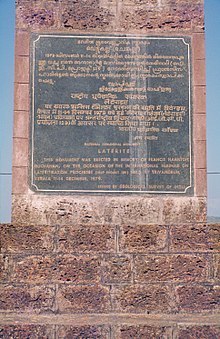
Fig 3.34 Monument of laterite brickstones
Formation
Laterite is often located under residual soils.
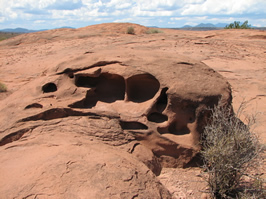
Fig 3.35
Soil layers, from soil down to bedrock: A represents soil; B represents laterite, a regolith; C represents saprolite, a less-weathered regolith; below C is a bedrock
Tropical weathering (lateralization) is a prolonged process of chemical weathering which produces a wide variety in the thickness, grade, chemistry, and ore mineralogy of the resulting soils.The initial products of weathering are essentially kaolinized rocks called saprolites. A period of active lateralization extended from about the mid-Tertiary to the mid-Quaternary periods (35 to 1.5 million years ago).Statistical analyses show that the transition in the mean and variance levels of 18O during the middle of the Pleistocene was abrupt. It seems this abrupt change was global and mainly represents an increase in ice mass; at about the same time an abrupt decrease in sea surface temperatures occurred; these two changes indicate a sudden global cooling. The rate of lateralization would have decreased with the abrupt cooling of the earth. Weathering in tropical climates continues to this day, at a reduced rate.
Laterites are formed from the leaching of parent sedimentary rocks (sandstones, clays, limestones); metamorphic rocks (schists, gneisses, migmatites); igneous rocks (granites, basalts, gabbros, peridotites); and mineralized proto-ores;which leaves the more insoluble ions, predominantly iron and aluminum. The mechanism of leaching involves acid dissolving the host mineral lattice, followed by hydrolysis and precipitation of insoluble oxides and sulfates of iron, aluminum, and silica under the high-temperature conditions of a humid subtropical monsoon climate.
An essential feature for the formation of laterite is the repetition of wet and dry seasons. Rocks are leached by percolating rainwater during the wet season; the resulting solution containing the leached ions is brought to the surface by capillary action during the dry season. These ions form soluble salt compounds which dry on the surface; these salts are washed away during the next wet season. Laterite formation is favored in low topographical reliefs of gentle crests and plateaus which prevents erosion of the surface cover. The reaction zone where rocks are in contact with water—from the lowest to highest water table levels—is progressively depleted of the easily leached ions of sodium, potassium, calcium, and magnesium. A solution of these ions can have the correct pH to preferentially dissolve silicon oxide rather than the aluminum oxides and iron oxides.
The mineralogical and chemical compositions of laterites are dependent on their parent rocks. Laterites consist mainly of quartz, zircon, and oxides of titanium, iron, tin, aluminum, and manganese, which remain during weathering. Quartz is the most abundant relic mineral from the parent rock.
Laterites vary significantly according to their location, climate, and depth. The main host minerals for nickel and cobalt can be either iron oxides, clay minerals, or manganese oxides. Iron oxides are derived from mafic igneous rocks and other iron-rich rocks; bauxites are derived from granitic igneous rock and other iron-poor rocks. Nickel laterites occur in zones of the earth that experienced prolonged tropical weathering of ultramafic rocks containing the ferromagnesian minerals olivine, pyroxene, and amphibole.
Uses
Agriculture
Laterite soils have a high clay content, which means they have higher cation exchange capacity and water-holding capacity than sandy soils. It is because the particles are so small, the water is trapped between them. After the rain, the water moves into the soil slowly. Palms are less likely to suffer from drought because the rainwater is held in the soil. However, if the structure of lateritic soils becomes degraded, a hard crust can form on the surface, which hinders water infiltration, the emergence of seedlings, and leads to increased runoff. It is possible to rehabilitate such soils, using a system called the 'bio-reclamation of degraded lands'. This involves using indigenous water-harvesting methods (such as planting pits and trenches), applying animal and plant residues, and planting high-value fruit trees and indigenous vegetable crops that are tolerant of drought conditions. They are good for oil palm, tea, coffee, and cashew cultivation. The International Crops Research Institute for the Semi-Arid Tropics (ICRISAT) has employed this system to rehabilitate degraded laterite soilsin Niger and increase smallholder farmers' incomes,it is used in Karnataka.
Building blocks
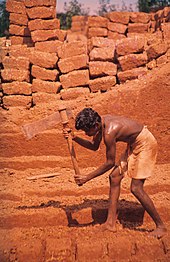
Fig 3.36 Cutting laterite bricks in Angadipuram, India
When moist, laterites can easily be cut with a spade into regular-sized blocks.Laterite is mined while it is below the water table, so it is wet and soft. Upon exposure to air, it gradually hardens as the moisture between the flat clay particles evaporates and the larger iron salts lock into a rigid lattice structure and become resistant to atmospheric conditions.[3]:1 The art of quarrying laterite material into masonry is suspected to have been introduced from the Indian subcontinent.
After 1000 CE Angkorian construction changed from circular or irregular earthen walls to rectangular temple enclosures of laterite, brick, and stone structures. Geographic surveys show areas that have laterite stone alignments which may be foundations of temple sites that have not survived.The Khmer people constructed the Angkor monuments—which are widely distributed in Cambodia and Thailand—between the 9th and 13th centuries. The stone materials used were sandstone and laterite; brick had been used in monuments constructed in the 9th and 10th centuries.Two types of laterite can be identified; both types consist of the minerals kaolinite, quartz, hematite, and goethite.Differences in the amounts of minor elements arsenic, antimony, vanadium, and strontium were measured between the two laterites.
Angkor Wat—located in present-day Cambodia—is the largest religious structure built by Suryavarman II, who ruled the Khmer Empire from 1112 to 1152.[17]:39 It is a World Heritage site. The sandstone used for the building of Angkor Wat is Mesozoic sandstone quarried in the Phnom Kulen Mountains, about 40 km (25 mi) away from the temple. The foundations and internal parts of the temple contain laterite blocks behind the sandstone surface. The masonry was laid without joint mortar.
Road building
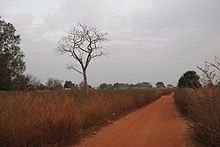
Fig 3.37 Laterite road
The French surfaced roads in the Cambodia, Thailand, and Vietnam areas with crushed laterite, stone, or gravel. Kenya, during the mid-1970s, and Malawi, during the mid-1980s, constructed trial sections of bituminous-surfaced low-volume roads using laterite in place of stone as a base course.The laterite did not conform with any accepted specifications but performed equally well when compared with adjoining sections of the road using stone or other stabilized material as a base.In 1984 US$40,000 per 1 km (0.62 mi) was saved in Malawi by using laterite in this way.
Water supply
Bedrock in tropical zones is often granite, gneiss, schist, or sandstone; the thick laterite layer is porous and slightly permeable so the layer can function as an aquifer in rural areas.One example is the Southwestern Laterite (Cabook) Aquifer in Sri Lanka.This aquifer is on the southwest border of Sri Lanka, with the narrow Shallow Aquifers on Coastal Sands between it and the ocean. It has a considerable water-holding capacity, depending on the depth of the formation.The aquifer in this laterite recharges rapidly with the rains of April–May which follow the dry season of February–March and continues to fill with the monsoon rains.The water table recedes slowly and is recharged several times during the rest of the year.In some high-density suburban areas, the water table could recede to 15 m (50 ft) below ground level during a prolonged dry period of more than 65 days.The Cabook Aquifer laterites support relatively shallow aquifers that are accessible to dug wells.
Wastewater treatment
In Northern Ireland, phosphorus enrichment of lakes due to agriculture is a significant problem. Locally available laterite—low-grade bauxite rich in iron and aluminum—is used in acid solution, followed by precipitation to remove phosphorus and heavy metals at several sewage treatment facilities. Calcium-iron- and aluminum-rich solid media are recommended for phosphorus removal. A study, using both laboratory tests and pilot-scale constructed wetlands, reports the effectiveness of granular laterite in removing phosphorus and heavy metals from landfill leachate. Initial laboratory studies show that laterite is capable of 99% removal of phosphorus from solution. A pilot-scale experimental facility containing laterite achieved 96% removal of phosphorus. This removal is greater than reported in other systems. Initial removals of aluminum and iron by pilot-scale facilities have been up to 85% and 98% respectively. Percolating columns of laterite removed enough cadmium, chromium and lead toundetectable concentrations. There is a possible application of this low-cost, low-technology, visually unobtrusive, efficient system for rural areas with dispersed point sources of pollution.
Ores
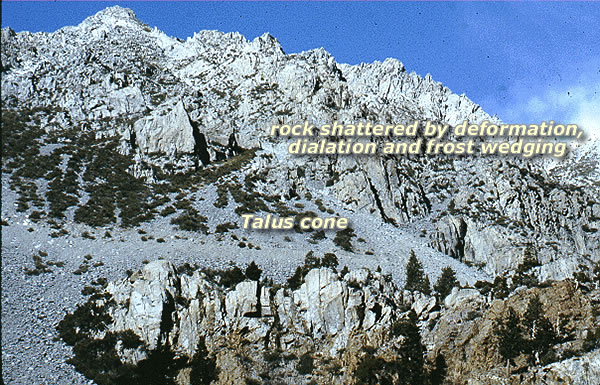
Fig 3.38 Cretaceous iron-rich laterite
Ores are concentrated in metalliferous laterites; aluminum is found in bauxites, iron and manganese are found in iron-rich hard crusts, nickel and copper are found in disintegrated rocks, and gold is found in mottled clays.
Bauxite
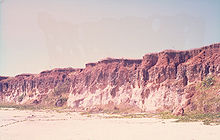
Fig 3.39 Bauxite on white kaolinitic sandstone
Bauxite ore is the main source ofaluminum.Bauxite is a variety of laterite (residual sedimentary rock), so it has no precise chemical formula. It is composed mainly of hydrated alumina minerals such as gibbsite [Al(OH)3 or Al2O3. 3H2O)] in newer tropical deposits; in older subtropical, temperate deposits the major minerals are boehmite [γ-AlO(OH) or Al2O3.H2O] and some diaspore [α-AlO(OH) or Al2O3.H2O]. The average chemical composition of bauxite, by weight, is 45 to 60% Al2O3 and 20 to 30% Fe2O3.The remaining weight consists of silica (quartz, chalcedony, and kaolinite), carbonates (calcite, magnesite, and dolomite), titanium dioxide, and water. Bauxites of economical interest must be low in kaolinite. The formation of lateritic bauxites occurs worldwide in the 145- to 2-million-year-old Cretaceous and Tertiary coastal plains. The bauxites form elongate belts, sometimes hundreds of kilometers long, parallel to Lower Tertiary shorelines in India and South America; their distribution is not related to a particular mineralogical composition of the parent rock. Many high-level bauxites are formed in coastal plains which were subsequently uplifted to their present altitude.
Iron
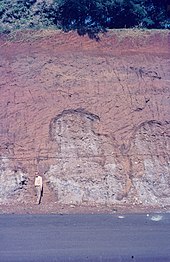
Fig 3.40 Laterite with a high iron percentage
The basaltic laterites of Northern Ireland were formed by extensive chemical weathering of basalts during a period of volcanic activity. They reach a maximum thickness of 30 m (100 ft) and once provided a major source of iron and aluminum ore. Percolating waters caused degradation of the parent basalt and preferential precipitation by acidic water through the lattice left the iron and aluminum ores. Primary olivine, plagioclase feldspar, and augite were successively broken down and replaced by a mineral assemblage consisting of hematite, gibbsite, goethite, anatase, halloysite, and kaolinite.
Nickel
Laterite ores were the major source of early nickel.Rich laterite deposits in New Caledonia were mined starting at the end of the 19th century to produce white metal.The discovery of sulfide deposits of Sudbury, Ontario, Canada, during the early part of the 20th century shifted the focus to sulfides for nickel extraction.About 70% of the Earth's land-based nickel resources are contained in laterites; they currently account for about 40% of the world's nickel production.In 1950 laterite-source nickel was less than 10% of total production, in 2003 it accounted for 42%, and by 2012 the share of laterite-source nickel was expected to be 51%.The four main areas in the world with the largest nickel laterite resources are New Caledonia, with 21%; Australia, with 20%; the Philippines, with 17%; and Indonesia, with 12%.
Areas where there is little or no vegetation are usually the most affected places that experience shaping due to wind. This happens when the wind picks up weathered rock materials and uses them to sand-blast larger rock structures on the zone closest to the ground. The formation of rock-strewn reg surfaces has resulted in the removal of finer material by wind. The wind also plays an important role in moving and reshaping dunes. Examples of landforms that are obvious in deserts are rock pedestals, Yardangs, Desert pavements, Deflation hollows, Oasis, and dunes.
Rock Pedestals

Fig 3.41 Rock pedestals
Rock pedestals are landforms created by abrasion in which grains cut away the base of rock structures but leave their tips intact. This is due to wind-borne sand grains following bouncing trajectories that carry sand as high as 1m above the ground.
Deflation hollows
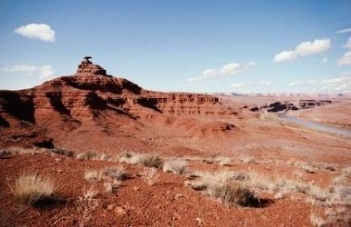
Fig 3.42 Deflation hollows
When the sand is carried away over long distances by the wind, depressions are formed in the area from which it lands. These depressions are called deflation hollows and are commonly found in non-mountainous arid regions. Deflation hollows are an example of wind erosion causing deflation yet these depressions also tend to collect rainwater and hold this water for a time depending on evaporation rates through the stones.
Oasis
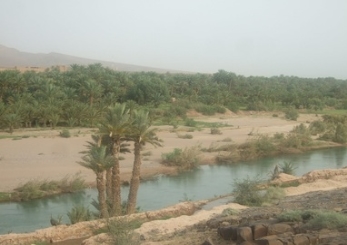
Fig 3.43 Oasis
Oasis is found in the middle of deserts as fertile spots containing one or more springs surrounded by vegetation. This is caused by a variety of different temperature extremes causing islands of life. This outcome is due to oases usually been located in parts of the desert where the elevation is low enough meaning the water table is underneath the surface, allowing life to grow through their roots extending into the moist land. Water can run right through the sand as it is holey hence why the water can stay underneath the surface especially when large quantities of sand are moved due to wind erosion.
Sand Dunes
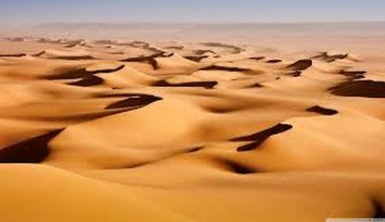
Fig 3.44 Sand dunes
There are two different types of sand dunes which are the barchan dunes and seif dunes. These are differentiated as barchan dunes are produced by the action of wind predominately convex facing from one direction forming crescent-shaped dunes, whereas the seif dunes are long and narrow or can be a chain of dunes. These dunes are generally orientated in a direction parallel to the wind or in a direction in which have been the result of two or more winds blowing at acute angles to each other. Wind directions can also alter the series of peaks, gaps, steepness, and the face of the sides. These sand dunes are mostly found in open deserts and rest on a base of a sand sheet. Dunes are a result of deposition processes.
Yardangs
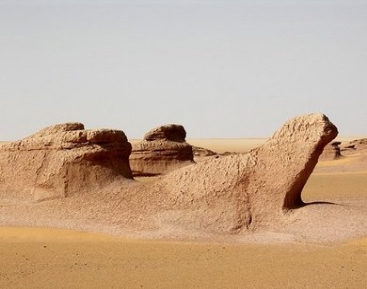
Fig 3.45 Yardangs
Yardangs are also the result of sand grains pushed by persistent winds to form low ridges of sand carved in soft rock. This is commonly found in flat deserts where steady winds blow away dust and silt. Higher front faces of Yardangs are undercut as erosion is concentrated in the lower areas because wind-driven sand stays near the ground. These are an example of erosional landforms
Desert Pavements
Pavements are commonly covered with stones rather than sand. This may be due to the wind blowing away the finest material leaving the stones behind as they are the bigger particles and remain as a lag deposit or maybe through various physical processes including the soil in the ground as the fine materials are moved down beneath the pebbles. This results in the stones remaining on top. Desert pavements can be used as mulch for plants or as a shelter for ants and rodents

Fig 3.46 Desert pavements
Pavements are commonly covered with stones rather than sand. This may be due to the wind blowing away the finest material leaving the stones behind as they are the bigger particles and remain as a lag deposit or maybe through various physical processes including the soil in the ground as the fine materials are moved down beneath the pebbles. This results in the stones remaining on top. Desert pavements can be used as mulch for plants or as a shelter for ants and rodents.
In some parts of the world, windblown dust and silt blanket the land. This layer of fine, mineral-rich material is called loess.Loess is mostly created by wind, but can also be formed by glaciers. When glaciers grind rocks to a fine powder, loess can form. Streams carry the powder to the end of the glacier. This sediment becomes loess.
Loess ranges in thickness from a few centimeters to more than 91 meters (300 feet). Unlike other soils, loess is pale and loosely packed. It crumbles easily; in fact, the word “loess” comes from the German word for “loose.” Loess is soft enough to carve but strong enough to stand as sturdy walls. In parts of China, residents build cave-like dwellings in thick loess cliffs.
Extensive loess deposits are found in northern China, the Great Plains of North America, central Europe, and parts of Russia and Kazakhstan. The thickest loess deposits are near the Missouri River in the U.S. state of Iowa and along the Yellow River inChina.
Loess accumulates, or builds up, at the edges of deserts. For example, as the wind blows across the Gobi, a desert in Asia, it picks up and carries fine particles. These particles include sand crystals made of quartz or mica. It may also contain organic material, such as the dusty remains of skeletons from desert animals.
On the far side of the desert, moisture in the air causes the particles and dust to settle on the ground. There, grass and the roots of other plants trap the dust and hold it to the ground. More dust slowly accumulates, and loess is formed.
Loess often develops into extremely fertile agricultural soil. It is full of minerals and drains water very well. It is easily tilled, or broken up, for planting seeds. Loess usually erodes very slowly—Chinese farmers have been working the loess around the Yellow River for more than a thousand years.
.
Fig 3.47 Loess
The Clay-with-flints Formation is a residual deposit covering chalk deposits or remaining after their dissolution, known under different names. It is an informal unit not mentioned on the stratigraphical scale, as is the case with all other residual weathering deposits or alterites.
Description:
The Clay-with-flints deposit covers the eroded top of the Cretaceous strata and is the result of the dissolution of the carbonate matrix, leaving a more or less stratiform concentration of flint embedded in clay-rich impurities, becoming more sandy towards its base or the edges of the Cretaceous depositional basin. In detail, the Clay-with-flints deposit may be deformed by epikarstic dissolution on the top chalk.
The volume and thickness of the Clay-with-flints unit depend on the depth of dissolution of the Cretaceous carbonates and their flint content. Without residual flints accumulating on a (karstic) dissolution surface, no Clay-with-flints deposit can form. Due to the weathering of a stratified carbonate deposit, with the residual concentration of its detrital admixture (clay, sand, locally gravel) or diagenetic (flint, locally phosphate pebbles), a superposition can be observed in the Clay-with-flints deposit as well, from the bottom to top mostly black flints from the ZevenWegen Member of the Gulpen Formation (covering a sandy to gravelly base corresponding to the Vaals Formation, which is strongly reduced to metric scale on the Brabant Massif), followed by impure greyish flints (and possibly also increased sand/silt concentrations) from the Vijlen Member, followed by larger variegated irregular ‘cavernous’ flints from the Lixhe Member, passing into grey flints of still larger dimensions from the Lanaye Member of the Gulpen Formation, and finally the coarser-grained flints of the Maastricht Formation, in which flints gradually disappear upward. Hence, preservation of the upper part of the Maastricht Formation strongly reduces the potential volume of the Clay-with-flints layer. When occurring on top of the Maastricht Formation the Clay-with-flints bed rarely attains 1 m in thickness and contains less clay, based on the low impurities content of the calcarenites composing this formation. The unit may be predominantly composed of silicified calcarenite (‘tauw’), which strictly speaking is not belonging to the Clay-with-flints formation, but which is rarely distinguished in borehole descriptions.
The most typical and clay-rich Clay-with-flints facies is found where this bed occurs on top of the chalk facies of the Gulpen Formation. Stratigraphic assignment of the flint to their original position within the Cretaceous sequence is mostly based on silicified micro- or macrofossils.
Solifluction is the name for the slow downhill flow of soil in arctic regions. It occurs slowly and is measured in millimeters or centimeters per year. It more or less uniformly affects the whole thickness of the soil rather than collecting in certain areas. It results from the complete waterlogging of sediment rather than short-lived episodes of saturation from storm runoff.
Solifluction Occurrence
Solifluction happens during the summer thaw when the water in the soil is trapped there by frozen permafrost beneath it. This waterlogged sludge moves downslope by gravity, helped along by freeze-and-thaw cycles that push the top of the soil outward from the slope (the mechanism of frost heave).
Identifying Solifluction
The major sign of solifluction in the landscape is hillsides that have lobe-shaped slumps in them, similar to small, thin earth flows. Other signs include patterned ground, the name for various signs of order in the stones and soils of alpine landscapes.
A landscape affected by solifluction looks similar to the hummocky ground produced by extensive landsliding but it has a more fluid look, like melted ice cream or runny cake frosting. The signs may persist long after arctic conditions have changed, as in subarctic places that were once glaciated during the Pleistocene ice ages. Solifluction is considered a periglacial process, as it only requires chronic freezing conditions rather than the permanent presence of ice bodies.
Mudflow, the flow of water that contains large amounts of suspended particles and silt. It has a higher density and viscosity than streamflow and can deposit only the coarsest part of its load; this causes irreversible sediment entrainment. Its high viscosity will not allow it to flow as far as a water flow.
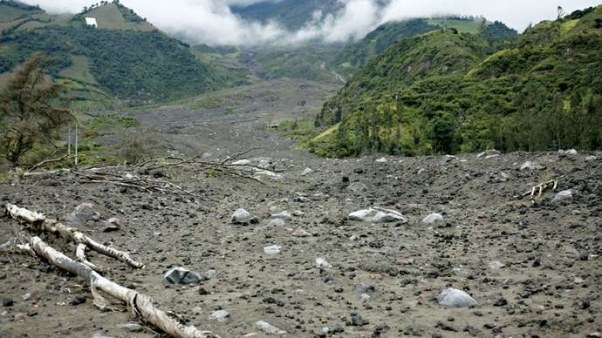
Fig 3.48 Mudflow on the Tungurahua volcano, Ecuador.
Mudflows occur on steep slopes where vegetation is not sufficient to prevent rapid erosion but can occur on gentle slopes if other conditions are met. Other factors are heavy precipitation in short periods and an easily erodible source material. Mudflows can be generated in any climatic regime but are most common in arid and semiarid areas. They may rush down a mountainside at speeds as great as 100 km (60 miles) per hour and can cause great damage to life and property. Boulders as large as houses have been moved by mudflows.
Mudflow deposits are poorly sorted mixtures of silt, boulders, organic materials, and other debris. They have abrupt and well-defined edges, irregular surfaces, and a lobate appearance; they may be 3 to 6 m (10 to 20 feet) high. Such deposits are extensive on alluvial fans and around the bases of many volcanoes.
3.20 Coastal Deposition
A deposition is a geological process where soil, rocks, sand, and other sediments become added to an existing landscape. During the transportation of sediments and materials, waves may sometimes lose energy, and when they do, sediments may drop out and begin to settle down. This is what we refer to as the process of Coastal Deposition.
Deposition happens when the different forces of waves and wind struggle to overcome the impacts of gravity. This clashing of forces generates friction and subsequent transportation that eventually leads to deposition. In short, deposition occurs when water and wind cannot hold the different materials in the fluid, thus resulting in a subsequent build-up of sediment.
Waves play a major role in the transport of these sediments. A deposition usually happens when the swash, or the forward movement of waves, is stronger than the backwash, or the backward movement of waves. Because of this, coastal deposition is usually the product of constructive waves, where the swash is stronger than the backwash, but that does not mean that destructive waves cannot result in a coastal deposition.
The longshore drift is the movement of sediments along the beach by the swash and backwash of waves that hit the shore obliquely. The swash of waves carries and deposits material up a beach at an angle, while the backwash flows back to the sea at 90º because of the influence of gravity. The angle at which waves hit the shore greatly affects how different materials are deposited.
The different sediments and materials that are transported and deposited may sometimes differ in grain size depending on the energy of the waves. For example, if wave energy is high, large sediments are usually transported and deposited. In contrast, if wave energy is low, usually small sediments such as fine-grained particles are transported and deposited.
Various other aspects play a key role in this process such as the rate of transportation, climate change, weather patterns, storm surges, and other geological processes. With these in mind, coastal deposition significantly impacts the biodiversity situated alongside these beach areas.
A deposition is likely to occur in areas where there is little wind, where there is a decent supply of sediments and materials, when waves enter an area of shallow water, and when waves enter sheltered areas.
Landforms formed by Coastal Deposition
Because of the action of waves and coastal deposition, the build-up of materials and sediments usually results in the development and formation of different geological structures and landforms along shorelines. The following are a few examples of depositional landforms.
Beaches
Beaches are the temporary deposition of sand and shingle along the coastline and are the most common depositional landforms. In general, these structures protect the coast from the damaging effects of erosion.
Sandy beaches usually develop due to low energy, constructive waves, in sheltered bays. The action of these constructive waves usually results in gentle and flat profiles. On the other hand, exposed beaches usually have steep and rough profiles. Destructive waves along with their stronger backwashes make it so that pebbles are not able to move far up the beach, thus resulting in their steep profile. Lastly, storm beaches form due to aggressive weathers where waves hurl large materials such as boulders and large pebbles to the back of a beach.
Spits
Spits are another type of depositional landform that is unstable, narrow, long stretches of sand, that extend out into the sea. These usually form due to the action of longshore drifts, which move material obliquely along the coastline and can sometimes result in these extended landforms. Sandy spits usually form due to constructive waves, while shingle spits usually form due to destructive waves. These structures are usually characterized by hooked ends due to the changing wind directions, and wave refraction which carries the material into more sheltered areas.
Bars
Bars form when spits grow across bays, where the spit joins two headlands on either side of a bay. Like spits, these usually form due to the action of longshore drifts. Bars that enclose bays usually form lagoons, which are low-energy regions that have high rates of deposition.
Tombolos
Tombolos are depositional landforms that develop when spits or bars connect the mainland to an island. Once attached, these islands are referred to as tied islands. Since these involve the formation of spits and bars, tombolos are also formed through the action of longshore drifts.
Dunes are another depositional landform thatis characterized by small mounds and ridges of sand found at the top of beaches, above the reach of the waves. These landforms are formed due to the forces of wind that cause the build-up of sand. Obstacles that limit sand movement help give dunes their mounds and hill-like characteristics.
References:
1. Engineering and General Geology, Parbin Singh, 8th Edition (2010), S K Kataria & Sons.
2. Text Book of Engineering Geology, N. Chenna Kesavulu, 2nd Edition (2009), Macmillan Publishers India.
